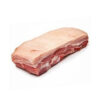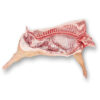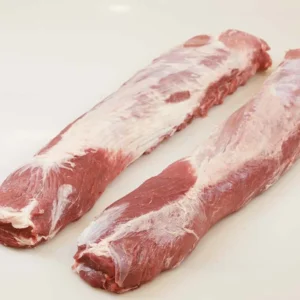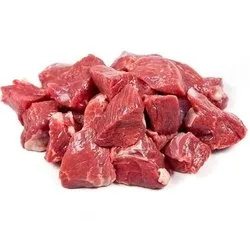Frozen Pork Bones
The Cold Truth About Frozen Pork Bones: A Guide to Buying, Storing, and Using Them
Pork bones are a culinary treasure, packed with flavor and versatility. They’re the foundation for rich broths, add depth to braises, and provide hours of chewing pleasure for your furry companions. But what happens when you can’t use them immediately? That’s where freezing comes in. Understanding the ins and outs of frozen pork bones is crucial for maximizing their flavor potential and ensuring food safety. This guide will walk you through everything you need to know, from selecting the best bones to storing them properly and unleashing their culinary magic.
Why Freeze Pork Bones?
Freezing pork bones is a fantastic way to:
- Extend their shelf life: Fresh pork bones can spoil quickly, especially if not stored properly. Freezing significantly extends their lifespan, allowing you to stock up when they’re on sale or readily available.
- Preserve flavor: While some subtle flavor loss may occur over extended periods, freezing effectively preserves the majority of the bone’s deliciousness.
- Prepare in advance: Having frozen bones on hand allows you to start making stocks and broths whenever the craving strikes, without the pressure of immediate use.
- Reduce waste: Freezing allows you to utilize leftover bones from roasts or chops, preventing them from ending up in the trash.
Choosing the Right Bones:
When selecting pork bones for freezing, keep these tips in mind:
- Freshness is key: Look for bones that are fresh, pink, and free from any unpleasant odors. Avoid bones that appear discolored or slimy.
- Bone type matters: Different bones yield different flavors. Neck bones are excellent for rich, gelatinous broths. Rib bones impart a smoky flavor. Knuckle bones offer a high collagen content for a silky texture. Consider your intended use when selecting your bones.
- Cut and size: Consider the size of the bones and how they will fit into your freezer. Smaller pieces freeze and thaw more quickly. If you’re planning to roast the bones before freezing, pre-cut them to a manageable size.
- Source matters: Opt for bones from reputable sources that practice responsible animal husbandry.
Proper Freezing Techniques:
Following the correct freezing procedure is vital for preserving flavor and preventing freezer burn:
- Cool Properly: If the bones are from a cooked roast, let them cool completely before freezing. This prevents the formation of ice crystals that can damage the texture.
- Portioning: Divide the bones into portions suitable for your future recipes. This allows you to thaw only what you need, minimizing waste.
- Packaging: Use airtight freezer bags or containers. Press out as much air as possible to prevent freezer burn. Consider vacuum sealing for even better protection.
- Labeling: Clearly label each package with the date and contents. This helps you keep track of how long the bones have been frozen and prevents confusion.
- Flash Freezing (Optional): For even quicker freezing and reduced ice crystal formation, consider flash freezing the bones individually on a baking sheet before packaging them.
Thawing and Using Frozen Pork Bones:
Thawing frozen pork bones safely and effectively is crucial for maintaining their quality:
- Refrigerator Thawing: This is the safest and most recommended method. Place the frozen bones in the refrigerator overnight or for up to 24 hours, depending on the size of the portion.
- Cold Water Thawing: If you need to thaw the bones more quickly, you can submerge the sealed package in a bowl of cold water. Change the water every 30 minutes to ensure even thawing. Never thaw bones at room temperature, as this can promote bacterial growth.
- Directly into Cooking: In some cases, you can add frozen bones directly to your cooking pot for stocks and broths. However, this will extend the cooking time.
Culinary Applications for Frozen Pork Bones:
Once thawed, frozen pork bones can be used in a variety of dishes:
- Stocks and Broths: This is the most common and rewarding use. Simmer the bones with vegetables and aromatics for a flavorful and nourishing broth.
- Soups: Add the bones to soups for added depth and richness.
- Braises: Use the bones to add flavor and moisture to braised meats and vegetables.
- Pet Treats: Cooked, unseasoned pork bones can be a delicious and nutritious treat for your dog, but always supervise them to prevent choking. Never give cooked bones to cats, as they splinter more easily.
Troubleshooting and Common Mistakes:
- Freezer Burn: Avoid freezer burn by using airtight packaging and removing as much air as possible.
- Off-Flavors: If the bones develop an off-flavor, it could be a sign of freezer burn or spoilage. Discard them.
- Overcrowding the Freezer: Avoid overcrowding the freezer, as this can slow down the freezing process and affect the quality of the food.
Conclusion:
Frozen pork bones are a versatile and cost-effective ingredient that can elevate your cooking to new heights. By understanding the proper methods for buying, freezing, and using them, you can unlock a world of flavor and reduce food waste. So, embrace the cold truth and start stocking up on these culinary gems today!
Be the first to review “Frozen Pork Bones” Cancel reply
Related products
Frozen Porc
Frozen Porc
Frozen Porc
Frozen Porc
Frozen Porc
Frozen Porc
Frozen Porc
Frozen Porc












Reviews
There are no reviews yet.